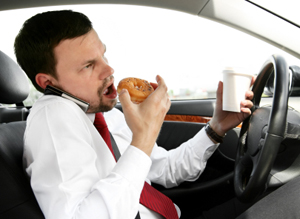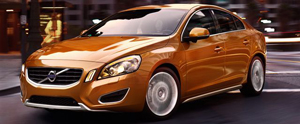Have you ever wondered why is it that a significant number of accidents occur on a straight road in optimal driving conditions? Forget drink driving, speed or even mechanical failure - sometimes it's a very small catalyst that leads to a serious accident.
With the rise of the touch screen smart phone and other gadgets that we can't seem to put down, it appears that drivers are being driven to distraction behind the wheel. Some commentators have gone as far as to say that 90% of accidents in a car occur as a result of driver distraction.
If pressed, most of us will admit to having used a mobile phone, sat-nav or even sipped a cup of coffee when driving. These are everyday examples of how easy it is to become distracted when driving and common as they are it begs the question - is anything being done to pro-actively improve safety around driver distractions or is it up to us to improve (and an Garda Siochana to police) our driving habits?
Can Technology Help?
 Euro NCAP
Euro NCAPObviously motor manufacturers take the business of safety very seriously. The European New Car Assessment Programme (NCAP) test (established in 1997) considers itself an important incentive for manufacturers to improve the safety of their cars. Competition for the '5 Star rating' is fierce with each participant hoping to make the agency's 'Top 5 Achievers'.
But improving safety is more than passing a test. As one manufacturer put it to me recently "Designing a car to pass a test is one thing. Designing a car to save lives is an altogether different challenge".
New Developments in Safety Features
Most of us expect our cars today to come standard with All-Round Airbags, Seat Belts Pre-Tensioners, ABS, Traction Control, Brake Assist Systems, Stability Control - etc. The list is almost endless but thankfully it's growing!
There are some very exciting new developments on the way. I had an opportunity to test drive Volvo's new S60 this week and was blown away by some of the safety features Volvo have developed. Their new "Pedestrian Detection System" is a serious piece of kit and could make accidents involving pedestrians a thing of the past.
A combination of onboard radar and specially designed camera's detect pedestrians and other moving objects in your way or about to step in front of you and will stop the car automatically if you don't. Unfortunately cameras weren't permitted in the testing area (all very hush hush at the time) but this short promotional movie will give you an idea of how it works.
So Why Are These Great Safety Features 'Optional Extras'?

I was so excited by this technology I couldn't wait to hear how it will come standard on the entire Volvo range. I had visions of the technology being licensed to all manufacturers and overnight - accidents involving pedestrians would be reconciled to history! Turns out it's not that simple. In a highly competitive market safety features are a great way of developing unique selling points. The reason they don't come automatically as standard comes down to cost. Most of this exciting technology costs millions to develop and invariably begins life as an 'Optional Equipment' in a bid to pay for themselves.
Just yesterday, new statistics from the Road Safety Authority showed that up to one third of all road collisions involve drivers who are using their vehicle for work. Company car drivers pay another form of tax for the private use of their company vehicles. It's called Benefit-In-Kind (BIK) and it's calculated against the Original Market Value (OMV) of the car. This means that adding safety features which will increase the OMV which in turn raises BIK and the employers lease costs haven't got a snowballs chance in hell!
The problem with optional safety equipment means that we are relying on the private every-day driver (the one that uses his iPhone and drinks coffee in the car) to recognise that he could do with some assistance in identifying pedestrians and be prepared to shell out a couple of grand for it. Not likely!
Economies of Scale
It all comes down to economies of scale. When a safety feature is first launched it carries the responsibility of a significant financial investment on the part of the manufacturer. Whilst it would be great if it could be included as 'Standard Specification' the reality is these features need to pay for themselves first. Introducing them as 'Optional Equipment' means the car can continue with a competitive purchase price with the 'option' of the safety feature for those interested.
 New Volvo S60
New Volvo S60In time, the cost of manufacture associated with the safety feature will drop as economies of scale kick in and eventually the feature pops up as standard on future models. But rather than relying on the responsible, safety-conscious driver who choses to add this option and make the afore mentioned scale a reality so that it becomes a 'Standard Feature' which will benefit the rest of us, isn't there anything the Government could be doing to speed up the process?
How many accidents could be prevented and lives saved if we changed the way we taxed safety features on cars? Take one safety feature offered by Volvo today as an example. "Adaptive Cruise Control with Collision Warning and Auto-Brake" is available as an option on the Volvo S80. This technology which is a pre-cursor to the pedestrian safety you saw above costs €1,600. It's a system that will automatically gauge the speed of the car in front of you in order to speed up or slow down your car while operating cruise control. Should the car in front jam on the brakes, the system intercedes and brakes on your behalf. A welcome intervention if you ever have cause to use it!
Government Action Required
If the Government decided to waive VRT and VRT the cost of this system would be reduced to €1,000. Its appeal as an option would increase and more sales would follow allowing Volvo to reduce the price even further. This would mean that the time it takes from introduction to promotion as 'Standard Feature' would be greatly reduced and our safety on the road promoted above Revenue concerns.
It's not as if the Government aren't getting their cut anyway. Remember for most of us, having €1,000 to spend means we had to earn closer to €2,000 before income tax and there's the healthy VRT and VAT take that's applied on the price of the car before extras.
Volvo are not alone in the pursuit of excellence in safety. Other manufacturers have some excellent features in development but as long as our Government continues to tax these innovations our ability to enjoy them as standard on the road will surely be compromised.